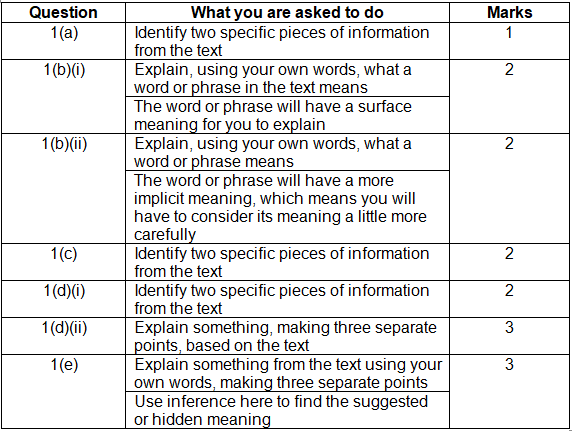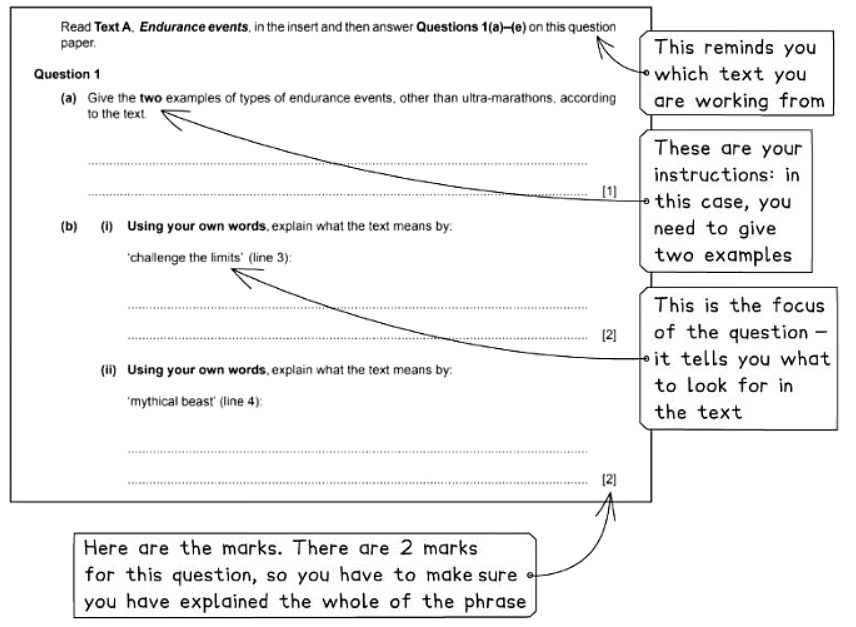Answering the Question 1: Comprehension | English Language for GCSE/IGCSE - Class 10 PDF Download
| Table of contents |

|
| How to Answer Question 1: Comprehension |

|
| Overview |

|
| Breaking down the questions |

|
| Steps to success |

|
| Exam Tips |

|
How to Answer Question 1: Comprehension
Paper 1: Reading is the obligatory examination in the CIE IGCSE, and CIE examiners advise adhering to the given question order. Question 1 consists of two parts: a comprehension task and a summary task. The comprehension task will revolve around Text A in your reading insert.
The following guide will provide you with the information you need to answer Question 1: Comprehension to a high standard. It includes:
- An overview of Question 1: Comprehension
- Breaking down the questions
- Steps to success
- Exam tips
Overview
In this assignment, you will answer a set of sub-questions regarding Text A. These questions evaluate your comprehension of both direct and implied meanings, as well as your capacity to extract and employ information from the text (Assessment Objectives R1, R2, and R5).
The sub-questions are valued at a total of 15 marks and are divided as follows:

Breaking down the questions
Question 1: Comprehension will be segmented into seven sub-questions. It's crucial to carefully read each question and identify:
- The imperative words in each question (indicating the required action)
- The emphasis of each question (highlighting the sought-after information in the text)
- The allocated marks for each question (indicating the required extent of response)
Question 1 example:

Steps to success
- Command words:
- "Read": You are instructed to read the question carefully.
- "Highlight": You are directed to identify and mark certain elements in the text.
- "Scan": You are prompted to quickly examine the text for relevant information.
- Focus of the question:
- You need to look for specific words, phrases, or evidence in the text that directly addresses the sub-questions.
- The instructions emphasize the importance of providing accurate evidence or explanations.
- Marks given for each sub-question:
- The number of marks allotted for each sub-question varies, and you should adjust the depth of your response accordingly.
- Approach to answering:
- Your responses should adhere to the question instructions.
- Ensure that you follow any specific guidelines, such as providing multiple examples if requested or paraphrasing instead of directly quoting from the text.
- Consider the context of the text when explaining the meaning of phrases.
- Some answers may require inference or interpretation rather than relying solely on explicit information from the text.
- Time allocation:
- It is advised to spend no more than 15-20 minutes on this question, including reading time.
By understanding and following these guidelines, you can effectively tackle Question 1 and provide accurate and appropriate responses.
Exam Tips
- Command words and paragraph references: Pay close attention to the specific command words used in the instructions, as well as the references to paragraph numbers.
- Avoid overly long explanations: Keep your responses concise and focused, avoiding unnecessary elaboration or repetition of the language from the text.
- Use your own words appropriately: Follow the task instructions regarding when to use your own words, ensuring that you provide explanations or answers as required.
- Avoid unnecessary material: Stay on track with the given sub-questions and refrain from adding extraneous information or unnecessary guesses.
- Follow the order of sub-questions: Work through the text systematically, addressing each sub-question in the order presented.
- Explain phrases comprehensively: When asked to explain a phrase in your own words, ensure that you provide a comprehensive understanding of the entire phrase, rather than focusing solely on individual words.
- Stick to specified paragraphs: Limit your analysis to the sections of text indicated in the question, as marks will not be awarded for information extracted from outside these specified paragraphs.
By adhering to these guidelines, you can effectively navigate the task and provide appropriate responses within the allocated time frame.
|
16 videos|45 docs
|
FAQs on Answering the Question 1: Comprehension - English Language for GCSE/IGCSE - Class 10
| 1. What is the main idea of the article? |  |
| 2. What are some tips for breaking down comprehension questions? |  |
| 3. How can students ensure that their answers are relevant to the given article title? |  |
| 4. Why is it important to consider questions that are highly searched on Google for the same topic? |  |
| 5. How can students ensure that the complexity of their questions and answers align with the text or exam level? |  |



















